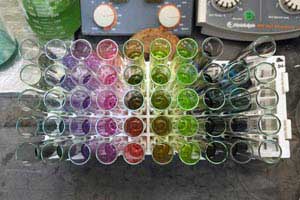| Posted: Jul 12, 2017 |
Teaching an old dye new tricks
(Nanowerk News) Radiation in the near-infrared region is invisible, but can deeply penetrate living tissue without damaging it. Dye molecules that produce near-infrared light consequently have valuable applications in medical diagnostics, and A*STAR researchers have developed a synthetic approach that can quickly identify ways to fine-tune their emission properties (Organic Letters, "Divergent synthesis of dihydroxanthene-hemicyanine fused near-infrared fluorophores through the late-stage amination of a bifunctional precursor").
|
 |
| A library of dye molecules synthesized with a ‘modular’ chemical approach may lead to improved imaging of live cells. (Image: A*STAR Institute of Chemical and Engineering Sciences)
|
|
One dye known as dihydroxanthene (DHX), although discovered nearly 20 years ago, has attracted a flurry of renewed interest after chemists discovered that small tweaks to a central ‘scaffold’ — an interlinked framework of three aromatic rings — could switch on bright, near-infrared fluorescence. Current synthetic methods, however, are ill-equipped to access a variety of analogs from a single DHX scaffold. This makes it difficult to comprehend how certain structures can maximize fluorescence.
|
|
Jean-Alexandre Richard from A*STAR’s Institute of Chemical and Engineering Sciences and co-workers aimed to explore DHX’s potential by taking a lead from medicinal chemists, who often generate libraries of potential drug candidates by reacting a common intermediate with a set of reagents. This technique, also known as divergent synthesis, significantly simplifies efforts to screen compounds with desirable properties.
|
|
“I saw potential for developing new chemistry to make these dyes because the reported routes were not flexible enough,” says Richard. “Our approach gives access to a number of molecules which would have been too time-consuming to obtain through purely de novo synthesis.”
|
|
To build their library of dyes, the team devised a divergent synthesis where two ‘chemical handles’ were attached to either end of the DHX scaffold. By giving the handles opposing electron-donating and -accepting capabilities, the team envisioned they could create conditions for a wide range of fluorescence levels. They identified that, by using aldehyde and aryl bromide handles, they could produce the initial scaffold in just one step and on a gram scale.
|
|
The researchers first systematically replaced the bromine handle with more than 20 amino-based donors, each with slightly different linear, cyclic, and aromatic structures. Then, they directly swapped the aldehyde handle with a charged aromatic ring group to boost DHX’s electron-pulling properties. Optical tests of the dye library enabled the team to rank the analogs in terms of their fluorescence intensity — data that may prove critical for tracking different components in complex biosystems.
|
|
The team is excited about the dye’s new potential. “The DHX dyes will complement the rather small number of near-infrared dyes now available, and encourage people to consider them a viable option for microscopy, diagnostics and imaging,” says Richard.
|

